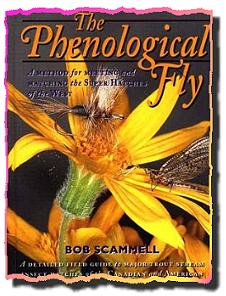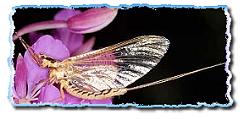Flowers, Bugs and the "The Phenological Fly"
The trees and flowers where you fish can tell you when your favorite hatches will start
by Clive Schaupmeyer
We've all been talking about El Nino this year because the weather
everywhere seems screwed up: excessive rain on the west coast, ice storms in
the east, and heat on the plains. In the FAOL chat room, eastern anglers have
reported some mayfly hatches two weeks earlier than usual. Some hatches
have finished in a few days instead of three weeks. What's a fly anglers to do?
All of this confusion with insects and climate. How are we to tell what's
happening on our favorite trout streams?
The answer may be the 'The Phenology Solution' as described in the
book, The Phenological Fly, By Bob Scammell; fellow Albertan,
fly-fisherman, and outdoor writer. In this book, Bob introduces us to the
subject of 'phenology,' and explains the basics. He gives many examples of
the relationships between our favorite insects and plants that inhabit the banks
and bushes along the streams.
 'Phenology' is the study of the timing of significant events that happen
every year in the lives of plants and animals. The flowers of plants and timing
of egg laying by birds are examples of these 'significant events.' According to
Scammell, he became intrigued with the possible relationships between aquatic
insects (like mayflies) and stream plants when he read a brochure published by
the Alberta Wildflower Society that said, ". . .(flowering) information is used
to . . . accurately predict insect outbreaks." As Bob says, "That inspired me."
'Phenology' is the study of the timing of significant events that happen
every year in the lives of plants and animals. The flowers of plants and timing
of egg laying by birds are examples of these 'significant events.' According to
Scammell, he became intrigued with the possible relationships between aquatic
insects (like mayflies) and stream plants when he read a brochure published by
the Alberta Wildflower Society that said, ". . .(flowering) information is used
to . . . accurately predict insect outbreaks." As Bob says, "That inspired me."
Allow me to digress a bit. . .here is southern Alberta, our spring is
perhaps three or four days ahead of 'average.' I know because our Mayday
tree in the back yard started blooming on April 29, and anytime it blooms in
April, then it is an early spring. But I've seen earlier. This tree bloomed on
April 22, one amazingly early spring. It first flowered around May 10 in one
terribly cold year. The date of the first bloom is, of course, directly related to
the heat we've had through out April.
This is a pretty easy concept to understand. The blooming of plants vary
with weather in the previous few weeks. Any fly angler worth their salt knows
the insects we cherish vary with the seasons as well. Some years our favorite
insects appear early and sometimes later than usual. But it gets more
interesting yet; the emergence of aquatic insects can be closely matched to
blooming of specific plants along the streambanks. And we can use this
knowledge to predict mayfly hatches.
 Scammell writes in The Phenological Fly that Charles Meck in
Great Rivers & Great Hatches notes that the blooming of
garden flowers seems to be related to the appearance of specific hatches.
But home gardens are also influenced by many things not present in nature.
Shammel's "phenology solution" uses the flowering of plants along trout
streams to predict hatches.
Scammell writes in The Phenological Fly that Charles Meck in
Great Rivers & Great Hatches notes that the blooming of
garden flowers seems to be related to the appearance of specific hatches.
But home gardens are also influenced by many things not present in nature.
Shammel's "phenology solution" uses the flowering of plants along trout
streams to predict hatches.
In Alberta we have a few streams where salmon flies (Pteronarcy's
californica) live. They hatch when the wild dogwood bushes are in bud. And
our Western Green Drakes emerge when marsh marigold bloom. Bob points
out that the relationships he discusses in his book apply in Alberta and may or
may not work where you live. The point is, you will find close relationships
between insect hatches and development of plants where you fish. He
recommends the use of short-season bloomers or other obvious events in plant
development. Dogwoods bloom for many weeks, so the actual blooming
period is of little use to predict hatches. But as noted above, the short
pre-bloom (bud) period is used to forecast the salmon fly hatch.
The two main factors that affect the timing of the flowering of wild
flowers along streambanks are temperatures (over a period of time) and
daylight length or photo periods. It takes a certain amount of accumulated heat
units and a certain day length to force plants to bloom. As it turns out these
two factors also affect the timing of aquatic insect emergence. So the climate
that affects the timing of the blooming of wild flowers also affects the
emergence of aquatic insects in the same way. Thus, the flowering plants along
our trout streams become "bug barometers."
Clearly there are many overriding factors. But after several years of
careful note taking, Bob feels that paying attention to wild flowers can help fly
anglers predict hatches.
The Phenological Fly is available in fly shops in Canada and the United
States. It is published by Johnson Gorman Publishers.
Clive Shaupmeyer
Return to Index
Copyright ©1998 Clive Schaupmeyer
Clive Schaupmeyer is an outdoor writer and photographer. He is the author of
The Essential Guide to Fly-Fishing,
a 288-page book for novice and intermediate fly anglers. His photo of a boy
fishing was judged the best outdoor picture of 1996 published by a member of
the Outdoor Writers of Canada. He fly-fishes for trout in Alberta's foothill
and mountain streams and for pike near his home in Brooks, Alberta.
Our Man In Canada Archives
|



